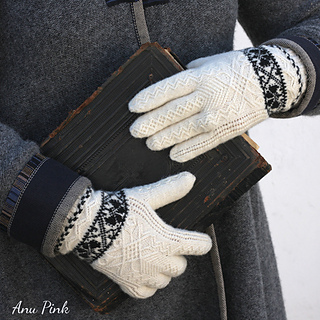patterns >  Saara Publishing House Blog
Saara Publishing House Blog
> Old Runö Gloves





Old Runö Gloves
This pattern is a copy of museum gloves in Estonian National Museum (museum number: ERM A 509:5278; link to museum’s online database).
This kind of gloves with luscious textured stitch patterns combined with black-white stranded patterns were knitted on the small island of Runö, which is situated on the SW of Estonia.
As they are a copy of museum gloves only one size is available and it is fit for a small to medium woman’s hand.
For this project you will need fine natural 10/2 white and black 100% wool yarn (50g of natural white and 15g of black). This pair of gloves on the picture is knit from “Hea kindalõng”
Best needles to use are 1,25 mm (US 0000) from Prym’s as they will not bend when knitting.
Tips for knitting these gloves:
First of all these gloves must be knitted tightly!
Chart shows the pattern of the back of the hand, palm side starting from row 46 is knit in plain knitting.
Herringbone cast-on is one of many traditional casting techniques used in old Estonian knitting. It is nicely explained in the Muhu book (named old cast-on) and will be explained in upcoming book about Estonian knitting history and techniques. In case you don’t have these books at hand, use any cast-on you like.
Rows 12-15 is horizontal chain:
-Knit the first stitch using the braid strand and the second stitch with the background color.
-Switch the position of the stitches, so that the braid stitch passes in front of the other. Do this by inserting the left needle into the braid stitch from left to right and pull the right needle out of both stitches.
-Pick up the background stitch again.
-Knit the braid stitch using the color required.
-Knit one stitch using the background color.
-Again, switch the position of the stitches, so that the braid stitch passes in front of the background stitch.
Rows 16-25 need a little trick also:
The zigzag travelling stitch band is specific to Ruhnu gloves and fingerless mitts. This stitch pattern requires switching a yarn over and a knit stitch, which is quite awkward to do. Knitting the left cross is easier, if the knit stitch is slipped onto the right needle, the yarn over is worked, and then the stitches are switched.
79 projects
stashed
88 times
- First published: September 2015
- Page created: September 12, 2015
- Last updated: September 15, 2015 …
- visits in the last 24 hours
- visitors right now




